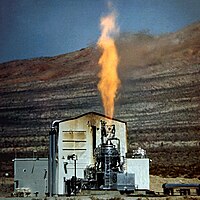Nuclear power in space

Nuclear power in space is a way to generate energy for spacecraft and space missions. It works by using the heat generated by nuclear reactions to produce electricity for the spacecraft.
Okay kiddo, do you know what a battery is? It's a container that stores energy to power other things like toys. But, what if you needed a lot of energy to do something far from Earth, like exploring other planets? A battery would not last long enough. That is why we use a special kind of battery called a nuclear battery that uses the power of atoms to create electricity.
When we send a spacecraft into space, it needs a lot of energy to operate all the machines and sensors inside. Nuclear power is a way to get a lot of energy from a small device, which is very helpful for space exploration.
A nuclear-powered spacecraft has a device inside called a reactor. It contains a small amount of a special material called uranium, just like the fuel used in a nuclear power plant on Earth. When the uranium atoms in the reactor collide, they release a lot of heat.
This heat is used to create steam, which spins a turbine, and generates electricity. The electricity is then stored in batteries which powers the spacecraft. Nuclear power is very efficient and can stay active for a very long time, even in space.
But, it's important to remember that nuclear power is very dangerous, and we need to be very careful with it. That is why NASA has safety guidelines for nuclear powered spacecraft, and there is a team of experts who monitor and control the reactor to make sure it's safe during launch and operation.
So, to sum it up, nuclear power in space is a way to generate electricity for spacecraft to explore other planets. It uses a special battery that generates electricity from atoms colliding inside a reactor. While it's efficient, it's also very dangerous and requires expertise and safety measures to be used properly.
Okay kiddo, do you know what a battery is? It's a container that stores energy to power other things like toys. But, what if you needed a lot of energy to do something far from Earth, like exploring other planets? A battery would not last long enough. That is why we use a special kind of battery called a nuclear battery that uses the power of atoms to create electricity.
When we send a spacecraft into space, it needs a lot of energy to operate all the machines and sensors inside. Nuclear power is a way to get a lot of energy from a small device, which is very helpful for space exploration.
A nuclear-powered spacecraft has a device inside called a reactor. It contains a small amount of a special material called uranium, just like the fuel used in a nuclear power plant on Earth. When the uranium atoms in the reactor collide, they release a lot of heat.
This heat is used to create steam, which spins a turbine, and generates electricity. The electricity is then stored in batteries which powers the spacecraft. Nuclear power is very efficient and can stay active for a very long time, even in space.
But, it's important to remember that nuclear power is very dangerous, and we need to be very careful with it. That is why NASA has safety guidelines for nuclear powered spacecraft, and there is a team of experts who monitor and control the reactor to make sure it's safe during launch and operation.
So, to sum it up, nuclear power in space is a way to generate electricity for spacecraft to explore other planets. It uses a special battery that generates electricity from atoms colliding inside a reactor. While it's efficient, it's also very dangerous and requires expertise and safety measures to be used properly.
Related topics others have asked about:
